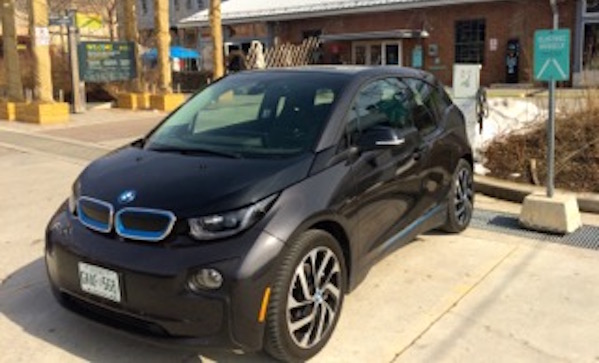Think of electric vehicles (EVs) as something similar to but different to traditional cars. Comparing the two is like Apple iPhones to Androids or humans to androids. They share many features but remain fundamentally different. Most EVs are strictly urban transport; all must exist within a larger context or infrastructure (as do traditional cars but we’re so deeply embedded, we’re mostly blind to it). However the last time I tried to write about BMW’s whole i gestalt, that wider context, this publication’s then-editor thought I was schilling für der mann and cut the dickens out of the story.
So we’ll try to skip the contexts and review the i3 strictly as a city tootler.
Unlike some EVs the i3 was created from the ground up to be electric, not adapted from a traditional gasoline-powered car’s chassis. So the engineers could ignore rules the combustion engines necessitate.
Much of the i3 is composed of carbon-fibre enforced plastic. Carbon fibre is far lighter but also far stronger than steel. So there’s less weight to transport, increasing the noticeability of your torque-off from green lights and passing lanes. And what weight there is—electric batteries are heavier than a Schenker brothers’ guitar duet—is strategically fitted to enhance drivability.
Speaking of placement, some city folks only care about getting from A to B. The i3’s not for them. From the get-go you have almost full torque—and like any BMW, the i3 is still very much about performance: more of an A to Z in 7.2 seconds than A to B in liberal-guilty enviro-gray. There are cheaper ways to save the world but few more thrilling on the way to work.
Still, you probably won’t abuse that latent power much. There’s something calming about being in this almost silent space (which the Suite Interior World and Technology packages enhanced marvelously in this tester). You quickly think of this less as a traditional car and more as really good city transport. Driving becomes a game: how long can you last on a charge? Think back to wringing the longest distance possible out of that all-you-can-eat Euro-value train ticket your parents bought you for graduating.
We’ll also report its limited juice range.
The i3 does not pretend to be anything but an urban ride. On a full charge, this tester listed a 128km range on strictly electric power. That ain’t much. But remember electric batteries are bulky and heavy as hell. Furthermore, forgive the wider context, studies show that most drivers commute far less than that daily. So, rather than storing more battery bulk, when the i3’s is drained, a tiny twin-cylinder gasoline engine with a supermodel’s appetite of 7.3 litres kicks in—recharging the battery, not powering the car—and thereby extending the range approximately another 90km.
It’s a sensible idea, stealing a bit of hybrid thinking for your EV rather than force-fitting traditional car design into hybrid or electric territory. Then there’s how the regenerative braking soaks up the kinetic energy we drivers create simply by moving. By tapping the brake or simply just taking your foot of the accelerator, you’re re-generating the battery.
After my second day, I almost never touched the brake. (Despite the ongoing revelations and the differentness of the experience behind the wheel, it’ll shock you how quickly you acclimate.) Take your foot off the pedal under 50km/h on a flat surface and you come to a complete stop within a few meters. Coast down a hill and presto, you again add more juice to the battery. A 128km range (not including the extra available 90) sometimes lingers at 128km for over 10 minutes of driving.
That is, until some dickhead cuts you off and you use the insta-blast in the pedal to silently teleport ahead and let him eat your lack of exhaust.
As you can see, it’s hard to parse the qualities that separate the i3 from its larger context—or from politics. Nonetheless . . .
We’ll even say that, from the outside, the BMW i3 is kinda funny looking.
First—inside, the i3 is gorgeous with its elegantly simple design motif, contrasting bamboo as an accent against carbon fibre walls. Like being in a chic downtown spa designed by Mies van de Rohe.
Outside the i3 is intentionally not everyone’s cup of tea. With stunted pug features up front (where there’s extra trunk space beneath the hood) back doors that actually open backwards, and an excessively long, progressively tinted windshield, the i3 is at best described by that wonderful French expression jolie laide.
But whatever city dweller buys it is clearly a very different type of driver and will embrace its unique look like the way Prius and smartcar owners do. Of course they’re making a fairly loud statement but we’ve already agreed that it’s hard to parse the politics and context when talking EVs.
Base price: $49,300
Technology package: $2,500
Suite Interior World: $4,250
As driven: $56,800


